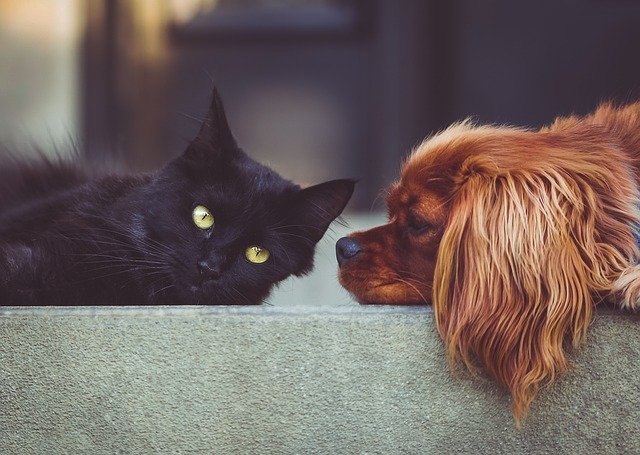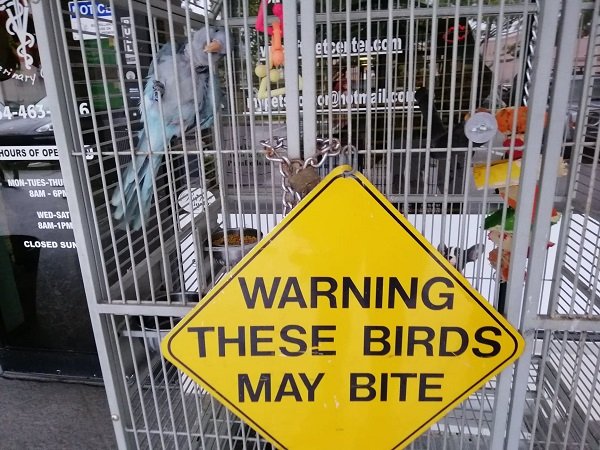Quaker Parrots aka the Monk Parakeets are the epitome of true parrots with impressively enormous personalities encased in tiny bodies. Having them never makes any parrot owner miss having a big parrot species at home. One of the most petted parrot species across the globe, Quakers owe their popularity to varied factors like small-size, playful persona, excellent talking abilities, exceptionally developed mimicking skills, and rare intelligence. This article is no short of any bible of Quaker parrots with covering every fact about Quakers.
Quaker Parrot Habitat
Quaker parrots originated from Argentina and the surrounding South American nations including Brazil, Bolivia, and Paraguay. Though these little creatures are native to temperate and subtropical areas, they adapt pretty well to almost all kinds of environments and climates. They are extremely comfortable in the urban setup and have been declared as feral in many parts of Europe and North America. In their natural habitat, the wild Quakers are mostly found in flocks.
The size of wild Quaker parrot flocks can consist of a few birds to over hundreds of them. They feed on seeds, fruits, grass, flowers, buds, berries, and insects in the wild. A large flock of wild Quakers can easily destroy a farmer’s crops because of which these birds are considered as pests by the cultivators. The UK had a population of 77 Quakers in 2011. Here are measures from the UK government in controlling the population of Quakers.
Quaker Parrot Lifespan
A Monk parakeet or a Quaker parrot has an average lifespan of 15-30 years. In the wild, these parrots live only up to 20 years in most cases. However, their lifespan can be extended to 30 years in captivity by providing them the care they deserve. Apart from feeding them a high-quality diet, Quaker parents need to consider many other things for extending their birds’ lifespan. Here are some of the best ways to increase the Quaker parrot lifespan.
Quaker Parrot Breeding
The breeding age of a Quaker parrot is 2 years and the period between mid-fall to early spring is classified as their breeding season. These little creatures breed 2 clutches a year each carrying 4-8 babies. One egg is laid every 24 hours and the incubation period is about 4 weeks. The second clutch is laid at the end of 4 weeks after the incubation period. It is extremely important to provide extra care to the breeding Quaker mother since a lot of her body’s nutrients are used up in laying eggs. She must be fed with foods rich in calcium, fats, proteins, fiber, and minerals to prevent any health complications.
Breeding behavior
A Quaker parrot’s breeding behavior is a lot different than his routine behavior. It is caused by the hormonal changes experienced by the bird during his breeding season. Aggression, biting, feather plucking, screaming, wing flapping, tail fanning, regurgitation, eye pinning, and territorial behavior can be observed commonly in Quakers during their breeding season. The owner must ensure to make necessary provisions to deter such behavior for the good of all. Pay a visit here to find out how to deter Quaker parrot’s breeding behavior.
Quaker Parrot Care
Adequate care helps in extending the lifespan of Quakers apart from helping them lead a quality life. Quaker parakeet care involves:
- Providing and maintaining a safe and comfortable living environment.
- Feeding the right food in the right proportions.
- Regular maintenance of hygiene.
- Spending time with him daily.
- Regularly visiting the vet for a full-body check-up to arrest any disease early on.
Baby Care
Caring for a Quaker parakeet baby is a lot different than caring for an adult Quaker. From the living environment to food, a Quaker baby needs special arrangements for growing into a healthy adult. It is essential to provide a brooder box with enough space for the babies and maintain the appropriate temperature inside it. Quaker parrot babies are hand-fed a commercial food mix since it carries all the necessary nutrients they require. Theoretically, the other care requirements of hygiene, full-body check-ups, and spending time are the same while practically the bird owner needs to perform these activities quite a lot for the baby bird.
A detailed guide on caring for an adult Quaker parrot can be found here while for a baby Quaker parrot here.
Quaker Parrot Health Problems
Just like humans, Quaker parrots are prone to both physical and mental health problems. Many of these issues can be prevented with adequate care and treating the problem as soon as it starts showing up the initial symptoms. It is, therefore, important to know the symptoms of various health problems that Quakers might face:
Symptoms
- Abnormal beak growth
- Aggression
- Bruising on beak or toenail
- Bulky stool
- Dehydration
- Diarrhea
- Discharge from eyes and nose
- Dry skin
- Excessive feather picking
- Excessive urination
- Fluffed or ruffled feathers
- Inflamed or red eyes
- Itchiness
- Lack of appetite
- Lethargy
- Regurgitation
- Trembling
- Vomiting
- Weight loss
The above symptoms can hint towards a bigger problem including the most common Quaker parrot diseases like Psittacosis, Polyomavirus infection, Pacheco’s disease, and Giardia infection. Prevention is always better than allowing an innocent bird to go through the pain of curing. Quaker parrot owners will benefit from this detailed guide to prevent the occurrence of any health problems in their pet birds.
Talking ability
Quaker parrots are among the top 5 parrot species that are considered the best talkers. Since these little creatures are good at mimicking sounds, they easily learn to mimic human speech as well. That said, Quaker parrots’ talking abilities are, therefore, dependent on their exposure to human speech. The more a Quaker owner interacts with his pet, the more his bird will learn to speak.
The talking abilities of Quaker parrots also vary from individual to individual and many factors are responsible for such development. Under certain circumstances, a Quaker might not utter a word and it will become extremely difficult for the Quaker parent to teach him. The details of such situations and different methods to get one’s Quaker parrot talking can be found here.
Quaker Parrot Diet
For a Quaker to live as long as 25 or 30 years, the factor that plays a major role is the healthiest diet in the world.
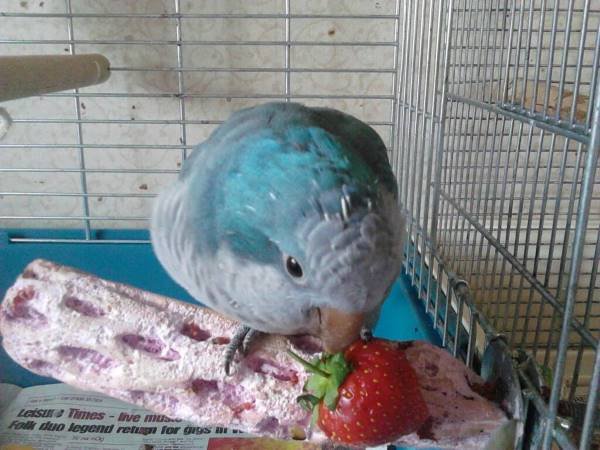
Serving a nutritious and wholesome diet is what takes care of not just the quantity but also the quality of Quaker’s life. With Quakers being famed foodies, they need a little of everything served well:
- Serve them pellets daily as they are a must to build the nutrition profile of these little parrots.
- Seeds are yet another favorite of Quakers and they gorge on them just as they do so in the wild.
- Adding fresh produce like fruits and vegetables make this diet wholesome apart from adding readily absorbable nutrients.
- Next on the checklist is providing a calcium or mineral block to cover up any probable deficiency.
- And lastly, do not forget to maintain an uninterrupted water supply to keep the bird hydrated and alive.
That said, just serving the diet doesn’t serve the purpose alone. One must take care of the ways certain things must be fed along with remembering the food items that shouldn’t be fed at all. To know more, read everything in detail here.
Cage
A cage is a place where pet Quaker parrots spend most of their time. Choosing the right cage requires a Quaker parrot owner to consider a lot of factors including its size, placement, and accessories. Comfortable roosting space inside the cage and a variety of perches must also be included. Provisions shall be made to keep this little home clean and hygienic for maintaining the physical health of the bird. The most important aspect of a bird’s cage is the safety it offers. A strong and well-built structure will ensure to make a Quaker parrot safe in his cage home.
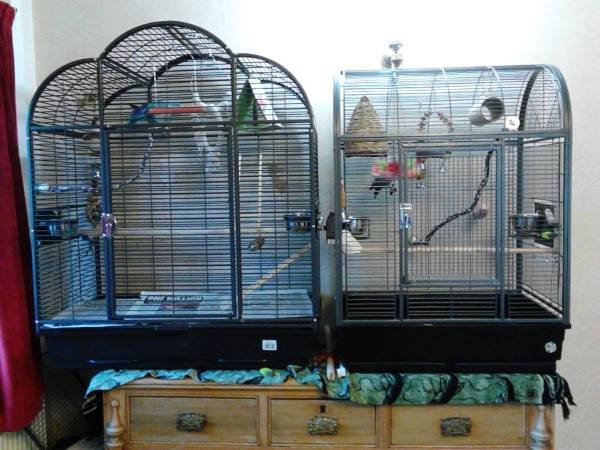
Additionally, a new Quaker parrot must not be kept in the same cage as the old one until they become good friends. Filling the cage with essentials like food and water, and providing entertainment sources to the bird is also important. Here is a detailed guide on preparing a Quaker parrot’s cage.
Behavior
Famed as flock lovers, Quakers are extremely social beings. This makes them quickly adapt to their new family. Leaving exceptions like traumatic past or abusive childhood, most of the Quakers have an affable disposition to them. And living with a Quaker proves to be quite a roller-coaster experience with good as well as bad days on the platter. Some of the very famous behavioral traits of Quaker parrots are summarized as:
- Quakers are extremely territorial and cannot tolerate another bird in their vicinity unless they become good friends.
- These little creatures are very noisy and like to express their emotions loudly.
- Quaker parrots are infamous for their biting behavior which makes it important to teach them not to bite. The reasons for Quakers’ biting behavior and measures to prevent such behavior can be found here.
- They are natural chewers and are unable to control their urge to chew upon different things.
- Eye pinning, head bobbing, and wing stretching are some behavioral displays shown by Quaker parrots during special circumstances.
- Regular preening is a part of Quaker parrots’ grooming behavior. It helps them clean up their feathers and moisturize their bodies.
Tame a Quaker Parrot
With inherent wilderness, Quakers need to be tamed well after adopted as pets. Also, with them being infamous for nipping hard if left untamed, it is always a wise idea to teach them the best ways to live in an indoor family setup.
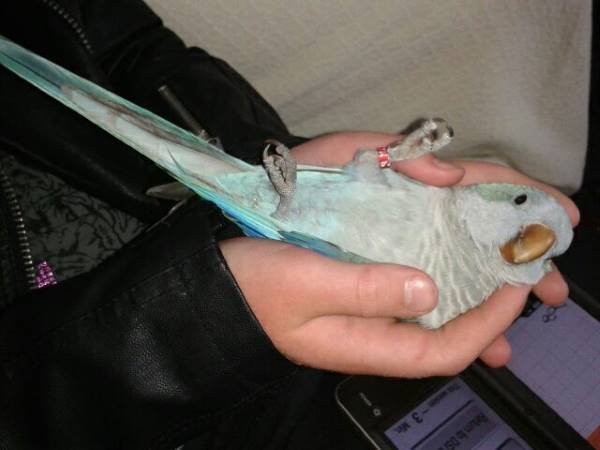
Unlike the popular notion, one can tame a Quaker quite easily. All one need is to adopt an easy approach that starts from winning the trust of the Quaker and have a fully tamed Quaker in a short span:
- However irrelevant it may seem, finding the perfect placement for the Quaker’s cage helps a great deal in winning his trust. And this not includes a suitable place for the cage but also a suitable angle and an apt view. Adding a perfect ambiance to the place is yet another factor.
- Once the parakeet feels comfortable in his new home and family members around, only then the progression would be fruitful. Now is the time to start building a bond with the bird. But don’t forget to be too assertive that the bird feels the bond forceful. Always start slow to stay organic. Choose various expert ways to interact with the Quaker.
- Once everything gets smooth with the newly adopted Quaker, one can put in some taming techniques in place. Such techniques would include a step-up technique that also happens to be the biggest success during taming a Quaker. But do not forget to add motivational practices while taming a Quaker.
- Lastly, to tame a Quaker quickly and successfully, one must ensure to steer clear of all the don’t while doing so. Here is a detailed version of taming a Quaker.
Quaker Parrot Training
Training a Quaker parrot is important to ensure his safety and develop a bond with him. Before initiating any kind of training, a Quaker parrot owner must win the confidence of his pet bird. Once the bird is comfortable with the owner, some basic training can be provided. Step-up techniques, stick training, and speech training can be added once the bird has started enjoying his time with the owner. Additional details about different methods of Quaker parrot training can be found here.
Quaker Parrot Grooming
Grooming of a Quaker is often neglected by new parents. Many beginners assume that grooming is probably only for humans. Also, their naturally cleaned feathers and sharpened nails and beaks while in the wild don’t help much to highlight their importance. But the reality is far from this. Quakers also need as much grooming as any other pet like dog or cat for the following reasons:
- Their feathers often trap a lot of dust and parasites that need to be removed regularly to keep the diseases at bay. Bathing and subsequent preening are meant to take care of Quaker’s feathers.
- Keeping the nails trimmed plays a huge part in firming the grip of Quakers in the wild, Where this task gets accomplished automatically in the wild, special care must be taken indoors.
- The beak of the Quaker has living tissues and hence, grows like nails. Thus, just like their nails, the bill of the Quakers also needs to be trimmed regularly.
- Lastly, for beginners, clipping the wings of their baby Quakers are as important as fastening the baby in the pram. It is all meant for their protection. But the key here is not to overdo it to cause inconvenience to the bird.
That said, grooming is not what is taught to the Quaker the very first day. They learn the process passively as they grow. So, to teach everything the right way, i.e. the bathing techniques, the preening ways, or the trimming of beak and nails, it is a must that the owner do it right first. To learn all the little details of Quaker’s grooming and all the do’s and don’ts, read the detailed version of Quaker’s grooming here.
Quaker Parrot Mutations
With all the love being showered on this species, it got inevitable for the breeders to start experimenting with their mutations. And after many years, today we have an almost endless list of quaker parrot color mutations that are equally adored across the globe.
The original Quaker or the green Quaker parrot has the inherent yellow pigment that tends to reflect the blue light off it (out of all the seven colors of the light spectrum). The combination of this blue and yellow makes the parrot appear green in color. And it is this pigment that the breeders tweak to produce varied Quaker color mutations.
The next most famed Quaker parrot is the blue version or the blue Quaker parrot. And then there come the technicalities in mutation with breeders offering blue Quakers of varying color shades like Turquoise and Aqua attracting Quaker lovers. So, how does all this color mutation technique work? And which color combination of Quaker parents give what outcome?
Quaker Parrot Price
An ever-increasing demand for Quakers leads to many asking the Quaker parrot price. And with varied Quaker parrot mutations like Blue, Albino, Pied, et al, the ranges are different for all. Add to this, the varying location factor; the fact that whether you choose a breeder or a pet store for the adoption process; the age of the parrot while adoption; whether the parrot is hand-raised or parent-raised; the prices vary further. And then there are options of ‘Quaker Parrot for sale’ online too. The Quaker market is a big thing.
These days the online searches like ‘Quaker parrot for sale UK’; or ‘Quaker parrot for sale near me’ have been on the rise. But before making an actual purchase, one must consider that price is not the only thing that will make an impact. It is the cost to raise a Quaker that is important and must be considered before taking the responsibility of a pet parrot. Apart from paying for the desired Quaker breed, many other costs must be considered including the cost of the cage, food, toys, grooming, medical, and other essential costs. To know how much raising a Quaker parrot would eventually cost throughout his lifetime, pay a visit here.
Quaker Parrot Gender Differences
Quakers belong to the monomorphic parrot category and are almost impossible to tell apart when it comes to their gender. The best way to sex a Quaker is to get the bird medically tested by taking his DNA. Unlike the traditional sexing techniques, it is a non-invasive method with 100% accuracy.
Many experts also follow the old-school method of visual sexing that is disputed when it comes to its accuracy. Additionally, many myths surrounding various parameters are thought to be deciding factors in finding out a Quaker’s gender. To help bust those myths and know how to sex a Quaker accurately, pay a visit here.
Quaker Parrot Nest
Parrots do not build their nests but Quakers are an exception. A Quaker Parakeet nest is a strong structure that can withstand winds blowing at 60 miles an hour. Since these parrots are extremely social, their nests also tend to depict this behavior. Quaker parrots love to create a huge nest out of twigs and sticks found in the wild.
These communal nests can weigh up to 200 pounds and can hold up to 20 pairs of Quakers. These architects of the parrot world understand the meaning of privacy extremely well. They create a separate room for each pair of birds for giving private space to them while living together as a group. More details about the unique structures created by Quaker parrots can be found here.
This natural nest making ability of Quaker parakeets can also be observed in the pet parrots as they pick a variety of things from their owner’s house to build a nest inside their cage. Though nest making is a necessity for the wild Quakers, it provides mental stimulation to the pet birds. It can, therefore, be used as a constructive activity in a pet Quaker’s routine.
Quaker Parrot Intelligence
Part of Quakers’ popularity as pets could be accredited to their intelligence quotient. They have earned many fans owing to their sharp mental abilities like:
- Exceptionally well communication skills;
- Talking right at right time and moment (in context);
- Mimicking abilities that are professional-like;
- Razor-sharp memory;
- Architectural skills that are put on display while building nests;
- Conceptual mental abilities that are evident while they play with foraging or puzzle toys;
- Learning things by associating them well; et al
For understanding how your favorite parrot does it, visit here.
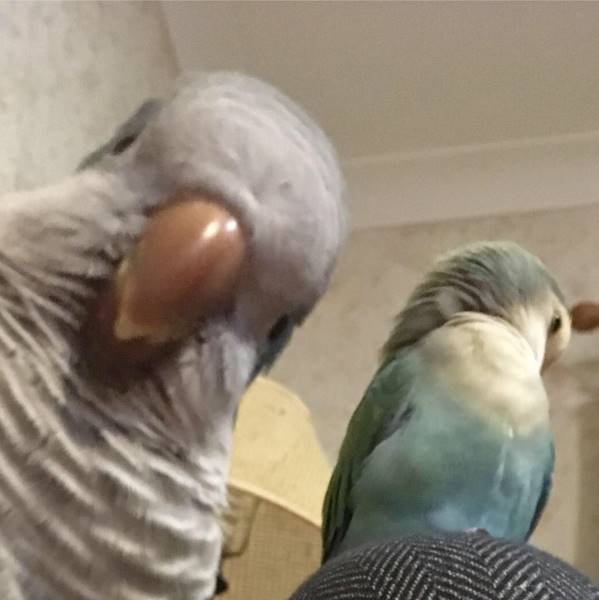
Summing Up
This article has pretty much everything about Quaker parrots that one might want to know about this famous bird pet. That said, if there is still any query left unanswered about Quakers, pay a visit here to read answers of all the frequently asked questions about Quakers. The questions on the list have been procured after going through the most searched queries. Hope you all find everything you need to know about your beloved pet. Happy parenting!


